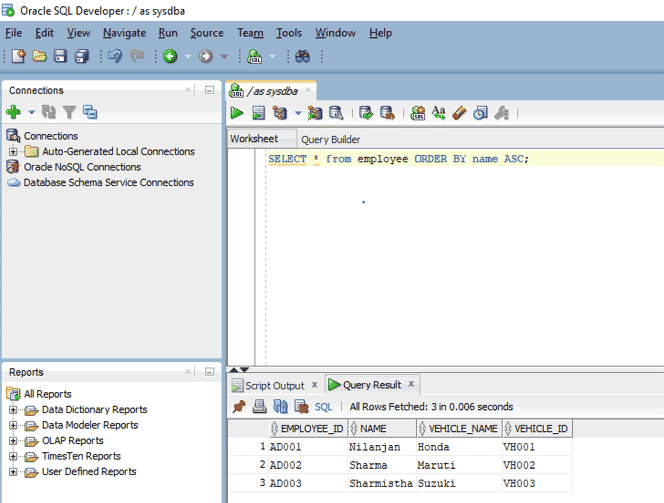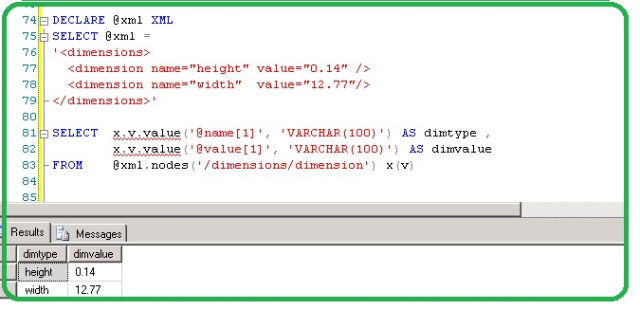

If you specify SHOW DEFAULTS and the input data is missing any optional elements or attributes for which the XML schema defines default values, then those elements or attributes are included in the output with their default values.

HIDE DEFAULTS and SHOW DEFAULTS apply only to XML schema-based data. If you omit this clause, then the behavior (pretty-printing or not) is indeterminate. If INDENT is present without a SIZE specification, then 2-space indenting is used. If N is 0, then pretty-printing inserts a newline character after each element, placing each element on a line by itself, but omitting all other insignificant whitespace in the output. Specify INDENT SIZE = N, where N is a whole number, for output that is pretty-printed using a relative indentation of N spaces. Specify NO INDENT to strip all insignificant whitespace from the output. Specify the VERSION clause to use the version you provide as string_literal in the XML declaration ( ). The xml_encoding_spec is an XML encoding declaration ( encoding="."). If datatype is BLOB, then you can specify the ENCODING clause to use the specified encoding in the prolog. The datatype specified can be a string type ( VARCHAR2 or VARCHAR, but not NVARCHAR2), BLOB, or CLOB. If you specify CONTENT, then the value_expr need not be a singly rooted XML document. If you specify DOCUMENT, then the value_expr must be a valid XML document. Relevant information Oracle Database 11g Enterprise Edition Release 11.1.0.7.XMLSerialize creates a string or LOB containing the contents of value_expr.Īny lob returned by XMLSERIALIZE will be read-only. Syntax: DECODE ( expression, search, result, search, result. The DECODE function is supported in the various versions of the Oracle/PLSQL, including, Oracle 12c, Oracle 11g, Oracle 10g and Oracle 9i. It is used to work as an IF-THEN-ELSE statement. 7 Answers Sorted by: 32 Try this instead: select xmltype (t.xml).extract ('//fax/text ()').

These aren't decoded properly, as can be seen in the example above.

I have no easy access to the Java code, but I do have control over the query used by the program.Īn example of Chinese characters that I use for testing is 激光, which Google Translate tells me means 'laser' and which I receive encoded as 激 光.
Oracle select xml decode pdf#
My actual problem involves Chinese characters, processed by a Java program to create PDF reports. CREATE TABLE xmltab ( Filename varchar2 (100), xmldata XMLTYPE ) Next, insert data from Test.xml into xml.tab by using the following command. First, create a table in Oracle that includes a column with data type XMLTYPE. The results I get are: METHOD HEARTS AMP_ENT AMP_DEC AMP_HEX CHINESE_LASERĭbms_nvert ♥ & & & 激 光 First approach: Load the XML file into an XML table and then parse it. Utl_i18n.unescape_reference('\& '), First approach: Load the XML file into an XML table and then parse it First, create a table in Oracle that includes a column with data type XMLTYPE. result (mandatory): This is what is returned if the search value mentioned previously matches the expression value. search (mandatory): This is the value to compare against the expression. SET ESCAPE ON ĭbms_nvert('\♥', 1) AS hearts,ĭbms_nvert('\&', 1) AS amp_ent,ĭbms_nvert('\& ', 1) AS amp_dec,ĭbms_nvert('\& ', 1) AS amp_hex,ĭbms_nvert('\激 \光 ', 1) AS chinese_laser The parameters of the Oracle DECODE function are: expression (mandatory): This is the value to compare. I've tried dbms_nvert and utl_i18n.unescape_reference but the results are less than satisfactory. I'm trying to decode html containing html entities.


 0 kommentar(er)
0 kommentar(er)
